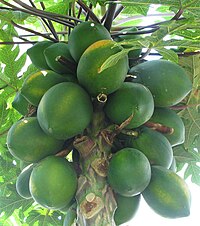Cookbook:Papaya
| Papaya | |
|---|---|
 | |
| Category | Fruits |
Cookbook | Recipes | Ingredients | Equipment | Techniques | Cookbook Disambiguation Pages | Ingredients | Fruit

The papaya is a melon-like tropical fruit with yellow-orange flesh enclosed in a thin skin that varies in color from green to orange to rose.
The papaya contains an enzyme called papain that is a meat tenderizer. It breaks down tough meat fibers. It is sold as a component in powdered meat tenderizer available in most supermarkets. Some people react badly to this when eating papaya.
Selection
[edit | edit source]Look for papayas that are partly or completely yellow in color, depending on variety, that give slightly to pressure, but are not soft at the stem-end. Avoid papayas that are bruised, shriveled, or have soft areas. Papayas that are hard and green are immature and will not ripen properly. Uncut papayas have no smell. Papayas that are cut should smell sweet, not bad or fermented.
Storage
[edit | edit source]Slightly green papayas will ripen quickly at room temperature, especially if placed in a paper bag. As the papaya ripens, it will turn from green to yellow. Place ripe papayas in a plastic bag and store in the refrigerator. Papayas will keep for up to a week, but it's best to use them within a day or two.
Varieties
[edit | edit source]There are two types of papayas, the Hawaiian and Mexican. The Hawaiian varieties, also known as Solo papayas, are found most often in supermarkets. These fruits are pear-shaped, weigh about a pound each, and have yellow skin when ripe. The flesh is bright orange or pinkish, depending on the variety. The Mexican varieties are not as common but can be found in Latino supermarkets. Mexican papayas are much larger then the Hawaiian types and can weigh up to 20 pounds and be more than 15 inches long. Although the flavor is less intense than the Hawaiian varieties, they are still delicious and enjoyable.